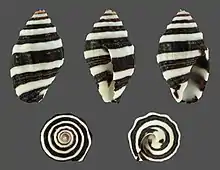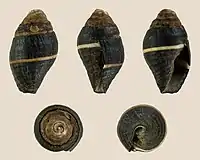| Engina mendicaria | |
|---|---|
 | |
| Shell of Engina mendicaria | |
| Scientific classification | |
| Domain: | Eukaryota |
| Kingdom: | Animalia |
| Phylum: | Mollusca |
| Class: | Gastropoda |
| Subclass: | Caenogastropoda |
| Order: | Neogastropoda |
| Family: | Pisaniidae |
| Genus: | Engina |
| Species: | E. mendicaria |
| Binomial name | |
| Engina mendicaria (Linnaeus, 1758) | |
| Synonyms[1] | |
| |
Engina mendicaria, common name striped engina or bumble bee snail, is a species of sea snail, a marine gastropod mollusk in the family Pisaniidae.[1]
Description

var. unilineata
The shell size varies between 10 mm and 20 mm. This shell shows a white or yellowish background with a few transversal black bands and resembles the yellow and black pattern of wasps and bees (hence a common name).
Distribution
This species is distributed in the Red Sea and in the Indian Ocean along Aldabra, Chagos, Kenya, Madagascar, Mauritius, Mozambique, Tanzania, in the tropical Indo-Pacific and Australia.
Habitat
These carnivore sea snails live on rocky shores and sand beds. They are mainly nocturnal.
References
- 1 2 Engina mendicaria (Linnaeus, 1758). Retrieved through: World Register of Marine Species on 5 November 2010.
- Dautzenberg, Ph. (1929). Mollusques testaces marins de Madagascar. Faune des Colonies Francaises, Tome III
- Kalk, M. (1958). The fauna of the intertidal rocks at Inhaca Island, Delagoa Bay. Ann. Natal Mus. 14: 189–242
- Richmond, M. (Ed.) (1997). A guide to the seashores of Eastern Africa and the Western Indian Ocean islands. Sida/Department for Research Cooperation, SAREC: Stockholm, Sweden. ISBN 91-630-4594-X. 448 pp.
External links
- "Engina mendicaria". Gastropods.com. Retrieved 5 November 2010.
This article is issued from Wikipedia. The text is licensed under Creative Commons - Attribution - Sharealike. Additional terms may apply for the media files.